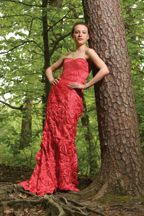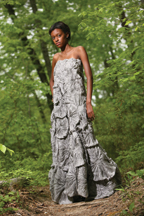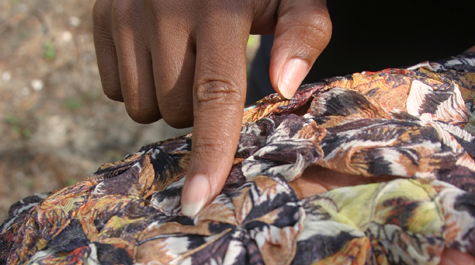Ecofashion: We're not only what we wear
“Some view ‘sustainable fashion’ as the ultimate paradox. Sustainability aspires to preserve the environment for future generations. Fashion, on the other hand, is constantly in flux and has long represented luxury and waste,” says Regina Root.
Root is associate professor of Hispanic studies at the College of William and Mary and also teaches courses on environmental and material culture. She is making a name for herself in the world of ecofashion academics, first as the editor of a special ecofashion-themed issue of Fashion Theory.
“Fashion Theory is one of the world’s leading sources for the field of fashion studies,” says Root, “so it was also a little intimidating to know that this volume was going to help define the role of sustainability as a category for analysis in fashion studies.”
The ideas that constitute ecofashion include attention to sustainable textiles or other materials, the emphasis on living wages for workers, the integration of local forms of knowledge into the design process and the terms of consumption—all in the service of personal expression.
Following the UK publication of Fashion Theory—a U.S. edition appeared three months later—colleagues at the London College of Fashion, along with an academic publisher, invited Root to co-edit a forthcoming international professional handbook. This work will outline the field of fashion studies, particularly as they relate to sustainability issues in a globalized world.
The ecofashion concept begins with the realization that we are, indeed, what we wear. But we’re also how it was made and how long we wear it.
“Dress is a powerful cultural tool that conveys meaning,” Root explained. “We have opportunities to behave sustainably on any given day. We define ourselves through the clothes we wear and when we opt for disposable clothing, we all pay the price.”
Increasingly eco-savvy consumers
Consumers are increasingly eco-savvy about the choices they make and how they spend their clothing dollars. Designers and the fashion industry at large are paying attention.
“Designers are pushed by consumers,” says Root. “The multi-billion-dollar fashion industry employs some 26.5 million people worldwide. Some think of fashion as haute couture—and it can be—but it can also be about change and innovation and renovation.”
In recent years, the visibility of ecofashion has been raised through various initiatives, including the United Nations’ Environmental Program, which promotes “cool green lifestyles that do not strain the planet or exploit people.”
“The idea is to educate the world about the impact of our lifestyles and consumption practices in particular,” says Root.
The choices are not always easy and rarely clear-cut. For instance, consider cotton. This natural fiber, the basis of denim and T-shirts, remains a popular fabric choice. Root pointed out that Europe and the United States consume almost half of the world’s cotton and also subsidize cotton production to keep clothing prices low.  “Interest in organic cotton is growing exponentially, in part due to an awareness of the effects of the pesticides used to grow conventional cotton, which deplete soil and can devastate the health of agricultural workers,” Root said.
“Interest in organic cotton is growing exponentially, in part due to an awareness of the effects of the pesticides used to grow conventional cotton, which deplete soil and can devastate the health of agricultural workers,” Root said.
But, for the ecofashionista, wearing organic cotton is neither a no-brainer nor a slam-dunk. First, there’s a little matter of supply and demand: “There is simply not enough organic cotton to satisfy the demand for the fiber,” she says.
Organic isn't necessarily better
“Moreover, when you factor in the manufacturing and dyeing process, some scholars argue that the entire life cycle of organic cotton may not be any more sustainable than its conventional counterpart,” Root explained. “So it’s important to remember that there are plenty of alternatives to cotton. We need to educate ourselves.”
Social and political forces shape culture; fashion is no exception. Root believes that the flows of international tourism and globalization have made it all the more necessary for design to be relevant to the communities it represents and serves. In short, sustainable communities produce sustainable clothes—and a community is sustained when its workers earn living wages.
“In Latin American design today, we are seeing a pronounced focus on the people involved in the manufacturing process,” Root explained. “This, in turn, has changed the whole sense of a designer’s authority and vision—and sometimes even the outcome of the final product.”
A prime example involves Brazilian designer Carlos Miele, who has collaborated with a women’s cooperative from Latin America’s largest shantytown, Rocinha, on the outskirts of Rio de Janeiro. The Rocinha Cooperative of Women’s Artisans and Seamstresses, or COOPA-ROCA, was initially founded in the 1980s by Brazilian sociologist María Teresa Leal. Women in the shantytowns, many of whom are skilled seamstresses, have always gathered to sew together, often making fuxico garments from textile scraps, a tradition with a deep cultural history in Brazil.
Fuxico is a lovely way to work with and recycle pieces of fabric that might get thrown away otherwise. These cloth rosettes might be called “yo-yos” by U.S. quilters or clothiers. Like quilt squares, fuxico rounds are sewed individually, then pieced together. The name comes from the verb fuxicar—to gossip—which is what often happens when you sit around a table in this Brazilian version of a quilting bee. During his early work with the Rocinha Cooperative, Carlos Miele received a UN Development Grant.
“He worked closely with members of the cooperative to produce haute couture to the high-precision industry standard, ensuring living wages and thereby elevating them from poverty,” says Root. “In essence, the project has helped create the antithesis of the multinational sweatshop. Today, the cooperative works with other prominent designers and labels throughout the world and truly serves as a model for what can happen when you have a greater sense of interconnectedness.”
No longer just about the designer
Of particular interest to Root is how the process tells a story about the relationship between the fuxico seamstresses and the design itself. On ecofashion catwalks, it’s no longer all about the designer. Materials, method of construction and other sustainability concerns also carry value. So a Carlos Miele garment produced by the cooperative carries an additional provenance that is interwoven with the “designer” label.
“This is what the industry often calls added value,” she said. “From my perspective, ecofashion’s greatest potential lies in its ability to inspire creative agency. Fashion can re-articulate the past, empower certain sectors of the population, enact change and produce cultural meaning. Ecofashion also provides a powerful response to the environmental crisis.”
In 2004 when Root proposed the concept of “ecofashion” to Berg Publishers, she stressed that the goal was to bridge disciplines and represent various world culture regions for the emerging field of sustainable-fashion studies. 
The resulting work outlined some of the problems in the worldwide fashion industry. Root noted that “big fashion” employs tens of millions of people—many of whom do not receive living wages. The industry also has a snowshoe-sized carbon footprint: Fashion still relies on dangerous chemicals to produce textiles for clothing and further exhausts limited fossil fuels to sustain its supply chains.
“The impact on climate change is undoubtedly significant,” Root says. In addition, fashion also promotes excessive consumption, she noted.
Business and supply chain models
Last year, Root began to collaborate with associate professor Tonya Boone from the Mason School of Business, an expert in sustainable operations and supply chain management. Their work links business and supply chain models to the processes for creating sustainable fashion. This includes an examination of the role of international agencies such as the United Nations and non-governmental organizations like Raíz Diseño, a transnational network of Latin American designers who view design as a useful tool in the struggle to acquire voice, power and market share in the international marketplace.
“I think that we will see the interest in sustainable fashion grow as more consumers in general become engaged around these issues,” says Boone. “Research suggests that while many consumers want sustainable goods, they are often not willing to pay premium prices for them. Still, I’ve seen estimates that indicate around 20 percent of the U.S. public are actively engaged in sustainable issues. This represents a considerable market segment.”
Boone predicted that as sustainable fashion supports consumers’ self-vision and self-expression, they will seek out sustainable fashions. “We plan to develop models of the sustainable design process, and then examine their effect on the fashion supply chain,” she said.
“There’s also a lot that the average consumer can do to behave more sustainably,” says Root. “The research shows that the most unsustainable stage of a garment’s life is actually while the consumer uses it. Washing, drying and ironing clothes takes a lot of energy. In response, some designers are engaging new technologies to manufacture clothing that is stain- and odor-resistant, so that we wash them less. There are also designers introducing clothing that can be reconfigured if it tears or has a stain. Choosing washable fabrics over those which must be dry-cleaned is also a fairly inexpensive step in the right direction.”
Boone said it’s not clear what effect the economy will have on the sustainable clothing segment of the apparel industry.
“On the consumer side, there are low-cost fashion and apparel products that have adopted environmental management systems. Right now it just looks like consumers have dramatically reduced spending,” says Boone. “On the business side, companies with sound strategies are more likely to weather the downturn and more likely to continue to support sustainability initiatives. Sustainability is compelling more companies to be more creative and resourceful. A lot of businesses are discovering that sustainability not only provides them with marketplace advantages, but more importantly, with operational opportunities.”
Several companies are discovering what Boone described as “powerful synergies” among environmental concerns and product quality and lean management systems. “For example, as a part of their sustainability strategy, Central Textiles—a supplier to the fashion industry, used quality management tools to simultaneously improve quality and reduce waste, which has reduced their costs and environmental impact.”
A multinational problem
Probably the biggest challenge to any fashion trend is the multinational nature of the fashion supply chain. Many of the fashion production processes take place around the globe. Uniting suppliers and subcontractors from dozens of different countries around sustainability initiatives is a challenge, Boone said.
“Nonetheless, some of the largest fashion, textile and apparel firms are committed to sustainability’s core values and we should continue to see changes in production processes and supply networks that improve environmental performance,” she added.
Ecofashion concepts are already moving from the designer-label world into the environmentally more important ready-to-wear arena. On the horizon, Root predicts better and more informational labeling—not unlike nutritional labeling on grocery store items—on garments.
“Some companies already provide this information, such as Patagonia’s ‘Footprint Chronicles.’ Patagonia has truly led by example, having switched from virgin to recycled polyester and from conventional to organic cotton well over a decade ago,” Root said. “They map out every aspect of their lines, starting from the fleece made from a PET plastic bottle or the cotton seed. Consumers can even return their products when they are done using them. This all then gets recycled into the next line of clothing. It’s quite remarkable.”
Not all designers or companies provide this kind of information, however. There is, quite likely, change on the horizon for the eco-conscious clothes shopper.
“When it comes to fashion, we now have several countries working towards international standards to certify what constitutes organic, fair trade, ethical and sustainable,” says Root. “Sustainable fashion continues to articulate new relationships to material culture. In fashion this means that the entire creative process is changing, with more designers recognizing the significance of their role as facilitators to a larger production process that will require sustainable materials and sustained livelihoods for the people involved.”
Ecofashion in the classroom
This fall, Root will import her ecofashion research into the classroom, as she will lead a freshman seminar on ethical fashion through the Sharpe Community Scholars Program, a William & Mary service-learning-based program. The course will focus on Latin American fiction, essays, photography and documentary films including Ropa Americana (American Clothes), which follows what happens to an old purple T-shirt after it doesn’t sell at Goodwill.
The film will highlight the transnational scope of the textile trade. Root said her seminar also will explore gender and labor practices in the maquila industry, the assembly plants in free trade zones that provide much of the cheap clothing to the United States market. “Clothing produced at a sweatshop comes at a hefty human and environmental price,” she said. “I know that the Sharpe Scholars will bring fresh perspectives to the field when we address these questions.”
 Skip to main content
Skip to main content


